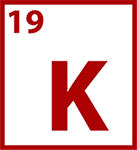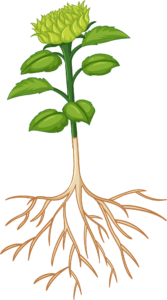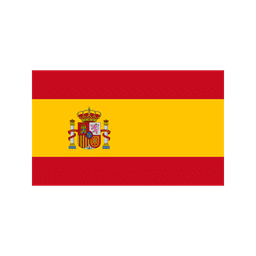Symbol: K
Availability: available to plants as the ion K+
Potassium functions

It regulates the water status in the plant and water and nutrients movement in plant tissue.


It is involved in the protein and starch synthesis.

It aids photosynthesis and promotes the translocation of sugars for plant growth or storage in fruits or roots.

It improves crop quality and increases the size of fruits and vegetables. It also reduces lodging of cereals.
Potassium (K) is an essential nutrient for plant growth. It’s classified as a macronutrient because plants take up large quantities of K during their life cycle. Unlike other major macronutrients, potassium is not incorporated into organic matter but remains as soluble ion (K+). Moreover, plants accumulate large amounts of K+ in their vacuoles, surpassing purely nutritional requirements. Hence, K+ is the most abundant cation in plant cells, comprising up to 10% of plant dry weight.
Plants take up K from the soil solution and since the exchangeable K is readily desorbed, most of it is easily available to plants. How much K a plant can use depends on two major factors, the type of clay mineral and K concentration in the soil solution. The availability of a nutrient not only depends on amounts or concentrations in soil but also on its mobility in soil. The mobility is needed for nutrients to reach the root surface. Very mobile nutrients, like NO3– which is not absorbed to the soil particles, can move several cm. Nutrients of low mobility, like K, though, will be depleted only close to the root itself. Therefore, only a small portion of the chemically available K is accessible to the plant and more roots a plant has, the more K can be taken up from soil. K+ is taken up from the soil solution by root epidermal and cortical cells. Once K+ is inside the root symplast, it may be stored in vacuoles, where it fulfills osmotic functions, or is transported to the shoot via xylem. In turn, shoot cells may also supply stored K+ for redistribution via phloem. In this transit from the soil to the different plant organs, K+ crosses various cell membranes through K+-specific transport systems. Coordinated operation of the different transport systems within the plant to secure K+ uptake from the soil and delivery to the different plant organs requires complex K+ sensing and signaling mechanisms.
Potassium is vital for plant metabolism and fulfills critical functions. Unlike N and P, K does not form any vital organic compounds in the plant. However, the presence of K is vital for plant growth because it is known to be an enzyme activator that promotes metabolism. Potassium “activates” at least 60 different enzymes involved in plant growth. Plants depend upon K to regulate the opening and closing of stomates, the pores through which leaves exchange carbon dioxide, water vapor, and oxygen with the atmosphere. Proper functioning of stomates is essential for photosynthesis, water and nutrient transport, and plant cooling. K regulates the water status in the plant, as a result, plants with an insufficient supply of K are much more susceptible to water stress. K helps photosynthesis and promotes the translocation of photosynthates (sugars) for plant growth or storage in fruits or roots. Potassium is also involved in the protein and starch synthesis, very important for crops like grains, such as corn and wheat and tubers such as potato and cassava. Potassium is also associated with the movement of water and nutrients in plant tissue. Potassium plays significant roles in enhancing crop quality. High levels of available K improve the quality (flavor and color), increase the size and shelf life of fruits and vegetables used for human consumption and the feeding value of grain and forage crops. Fiber quality of cotton is improved. Quality can also be affected in the field before harvesting such as when K reduces lodging of grains or enhances winterhardiness of many crops.
Potassium is a highly mobile element in the plant and is translocated from the older to younger tissue. Consequently, potassium deficiency symptoms usually occur first on the lower leaves of the plant, and progress toward the top as the severity of the deficiency increases. One of the most common signs of potassium deficiency is the yellow scorching, or firing (chlorosis), along the leaf margin. In severe cases, the fired margin of the leaf may fall out. However, with broadleaf crops the entire leaf may shed, resulting in premature defoliation of the crop.
Potassium-deficient crops grow slowly and have poorly developed root systems. Stalks are weak and lodging of cereal crops is common.
Plants lacking K will have slow and stunted growth, the size of seeds and fruits and the quantity of their production is reduced.
The K availability in the soil depends on several factors which include:
Fertile soil has the ability to hold reserves of many available essential plant nutrients, including potassium. This nutrient retention depends on the clay and organic matter in soil; potassium does not leach except to some extent from very sandy soils. The reserve of potassium provides a secure store which is available to the crop as it grows. However, the harvesting and removal of crops from the field will also remove the nutrients they contain, so depleting the soil reserve. An adequate reserve of potassium in the soil is necessary because of the large quantities required by the growing crop, and the function of potash fertilizers is to replenish this soil reserve. Potassium, like nitrogen and phosphorus, is a macronutrient because plants require large amounts of K. Depending on the crop, the K requirement can be nearly as high as the N requirement.
Organic and organo-mineral fertilizers are an excellent source of K for crop production, and they also help to improve poor soils and to avoid excess of salinity in the soil (which is the main problem with chemical
fertilizers). Potassium deficiency can result from a low content of K in the soil or from a poor absorption of potassium hindered by the presence of antagonist ions such as calcium and magnesium. In these cases, the application of foliar fertilizers is the ideal solution to bring K to the plant quickly and very effectively.
Potassium is the most abundant cation in plant cells.
It is an essential nutrient which fulfills critical functions for plant growth and metabolism.







